ePower Engine Systems, Inc.
Super-efficient Hybrid Conversion Kits For Long-haul...
Private Fundraise
This company may be interested in raising funds from accredited investors. You must Request Access to see more information about this company.
Request Access 9
In the US, 2.5 Million heavy-duty "Class 8" trucks with gross vehicle weights of 33,000 to 80,000 pounds consume 28 Billion gallons of diesel fuel and generate over 300 Megatons of CO2 per year.
Globally heavy-duty trucks consume 35% of ground transport fuel and generate 1.5 Gigatons of CO2 per year.
Heavy-duty trucking is, quite simply, one of the world's biggest and most highly concentrated fuel conservation and CO2 reduction opportunities.
ePower's fuel sipping hybrid conversion kits for heavy-duty trucks reduce fuel consumption and CO2 emissions by a third; and offer an unparalleled opportunity for impact investors.

In the US, truck manufacturers like Freightliner, International, Kenworth and Mack sell about 200,000 heavy-duty Class 8 tractors per year. There are two basic types of Class 8 tractors:
- Class 8A tractors are used for bulky and light cargo, haul up to 60,000 pounds and account for about 65% of truck traffic.
- Class 8B tractors are used for dense and heavy cargo, haul 60,000 to 80,000 pounds and account for about 35% of truck traffic.
The average fuel efficiency for Class 8A tractors is 6.1 mpg and the average for Class 8B tractors is 6.0 mpg.
The chassis and body of a Class 8 tractor have normal useful lives of 12 years, but the engine and transmission wear out after about 600,000 miles. In fleets that drive their tractors 120,000 to 200,000 miles a year, major overhauls every three to five years are a recurring maintenance event.
Based on available data, we believe fleet owners and garages across the country do 300,000 to 400,000 major overhauls a year at an average cost of $45,000. That represents an annual expenditure of $14 to $18 billion for the industry as a whole.
ePower Engine Systems has developed a super-efficient hybrid conversion kit for Class 8 tractors. ePower's target market is tractors that have been in service for several years and require a major overhaul, preferably their first overhaul.
Tractors equipped with ePower's third generation drivetrain have demonstrated the ability to consistently deliver fuel efficiencies of 9 mpg in the 55,000 pound weight class. ePower's fourth generation drivetrain with a 74,000 pound hauling capacity began demonstration trials in late-April.

In long-haul fleets that drive their tractors 120,000 to 200,000 miles per year, fuel consumption of 20,000 to 33,000 gallons a year is commonplace. In fact, fuel is the biggest cost in long-haul trucking and normally accounts for 35% of operating costs. While industry-standard fuel surcharge practices insulate fleet owners from price volatility, efficiency gains can have a huge impact on their profitability.

ePower's drivetrain conversion kits for Class 8 tractors are:
- Super-efficient, slashing fuel costs and CO2 emissions by 30% to 40%;
- Super-driveable, with a semi-autonomous architecture that let's truck drivers focus on the road instead of the truck;
- Super-reliable, with best-in-class components that are integrated into a novel drivetrain architecture; and
- Super-simple, modular kits that can be installed in any well-equipped garage.
With ePower, truckers can double or triple their profits while slashing their carbon footprints and conserving our precious natural resources.

Railroads are the world's most fuel efficient form of ground transportation and boast freight hauling efficiency of 480 ton-miles per gallon. Class 8 trucks come in second with average freight hauling efficiency of 130 ton-miles per gallon.
One big reason for the 350 ton-mile per gallon gap is drivetrain architecture:
- Locomotives use series-electric drivetrains where a diesel engine powers a generator and electric drive motors power the wheels.
- Conventional Class 8 tractors use mechanical drivetrains to power the wheels.
ePower has taken a page from the railroads' playbook and developed a hybrid series-electric drivetrain for Class 8 tractors. In ePower's drivetrain, a diesel engine powers a generator and electricity from the generator and an onboard battery pack are used to power a drive motor and transmission module.

ePower tractors don't look different, but they use best-in-class components in a fundamentally different drivetrain architecture.

ePower's foundation patent was issued in the US and Mexico during 2014. The patent's primary focus is ePower's novel use of an AC Vector Drive to combine AC current from a generator with DC current from a battery pack to deliver high-quality variable frequency AC current to an electric drive motor.
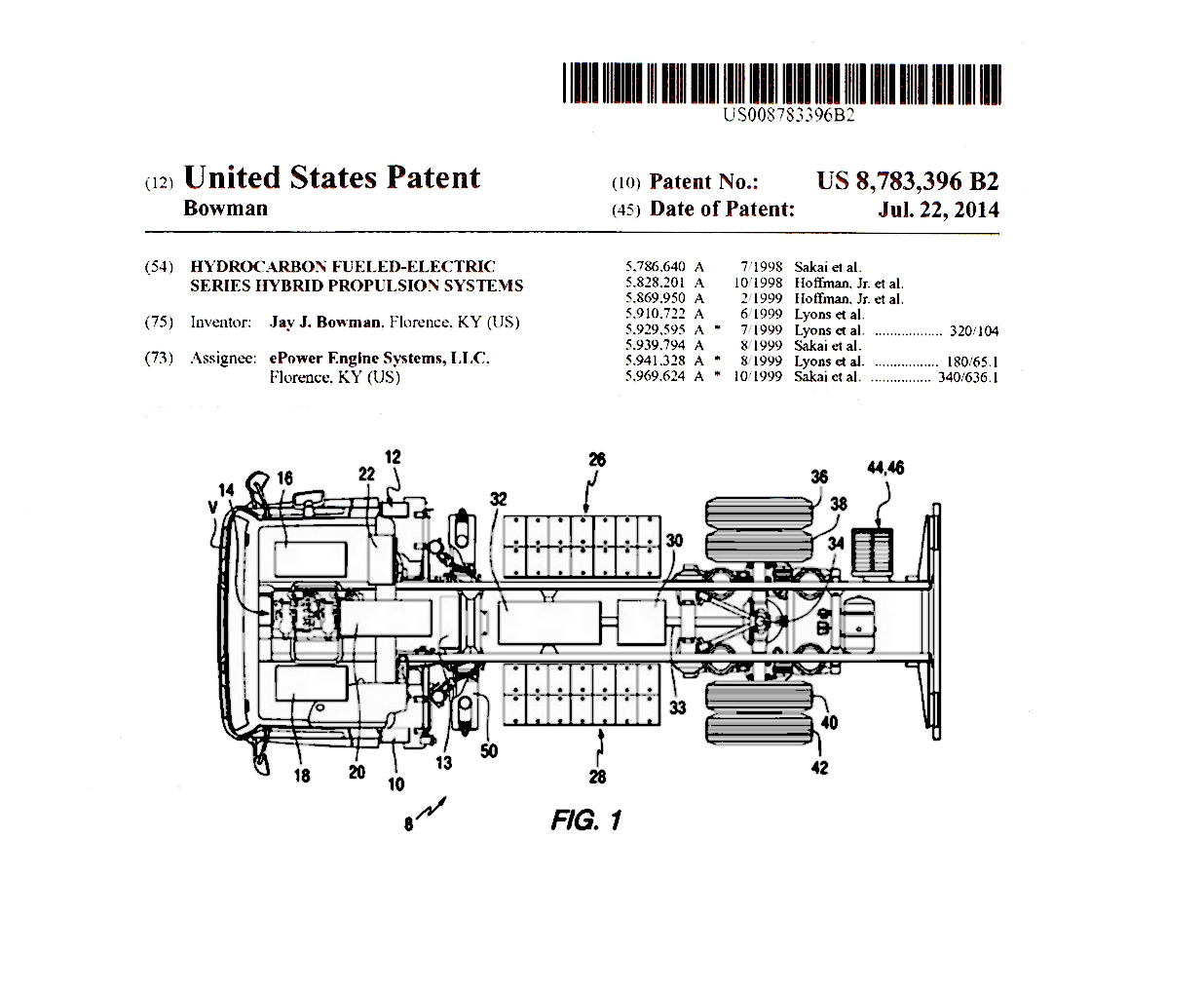
ePower's lawyers have received and responded to first round patent reviews in Canada, the EU, China and Hong Kong. Counsel believes ePower will ultimately obtain worldwide patent protection for its unique hybrid drivetrain architecture.

Heavy-duty trucks only need 200 hp to haul 80,000 pounds at highway speeds on flat and level ground, but they need up to 400 hp for acceleration and uphill grades. To meet these needs, truck manufacturers use 12- to 14-liter diesel engines that provide up to 400 horsepower on demand.
This graph summarizes the horsepower needed to haul an 80,000 pound load at 60 mph on a variety of uphill grades. Most Class 8 tractors rely on engine power alone to climb grades of 1.5% to 2%. For steeper grades, the transmission takes over and climbing speed slows.

ePower's series hybrid drivetrain uses a 6.7-liter diesel engine to provide 200 hp for steady-state cruising and an on-board battery pack to provide up to 200 hp on demand for acceleration and uphill grades. When a steeper grade requires more horsepower, the transmission takes over and climbing speed slows.
We can't change physics, but we can use a small diesel engine and a battery pack to deliver the same horsepower as a big engine for several miles.
Unlike conventional drivetrains that cycle engine speed up and down in response to a throttle, ePower's semi-autonomous control architecture runs the engine at a constant speed for optimal torque, power, fuel efficiency and engine life.

Recuperative Braking – Parallel hybrids like the Toyota Prius use small electric motors to augment large engines. While every hybrid drivetrain recovers "kinetic energy" from braking, electric motors can't recover more energy during braking events than they deliver during acceleration. That limits the recuperative braking efficiency of parallel hybrid systems in heavy-duty trucks.
ePower's series hybrid drivetrain uses a large electric motor to power the wheels and that large motor is significantly more efficient at recovering braking energy than the small motors used in parallel hybrid drivetrains.
Recuperative Terrain – In long-haul trucking, recuperative braking opportunities are rare, but opportunities to recover "potential energy" from changing terrain are plentiful. Since most uphill grades are followed by equal downhill grades, every hill, valley, ridge, gully and overpass offers an opportunity to recover energy that would normally be wasted.
ePower's series hybrid drivetrain has a unique ability to recover potential energy from changing terrain, something parallel hybrids simply can't do.

Cummins says, "The most efficient drivers get about 30% better fuel economy than the least efficient drivers." It's one of their Rock Solid Rules!
Caterpillar reports that the best drivers average 6.7 mpg while the worst drivers average 5 mpg.
Learning efficient driving habits takes years and with annual driver turnover rates approaching 100% most fleet owners find that efficient drivers are hard to recruit and even harder to retain.
ePower's series hybrid drivetrain uses advanced electronic and software controls to automate most drivetrain functions. While the throttle and brake give the driver total control over speed and braking, ePower's semi-autonomous architecture makes all of the nitty-gritty drivetrain efficiency decisions.
On-road testing has shown that highly skilled drivers can't outperform ePower's semi-autonomous architecture. More importantly, our testing has shown that inexperienced drivers perform every bit as well as seasoned professionals.
We believe our unique ability to take driver skill out of the fuel economy equation will be more important to fleet owners than our headline fuel efficiency number.

ePower is developing modular hybrid conversion kits for truckers who need to overhaul existing Class 8 tractors. The four primary modules are:
- A drop-in genset module that pairs a Cummins 6.7-liter diesel engine with a 150 kW generator from Marathon Electric;
- A bolt-on battery module that provides 150 kW of on-demand power for acceleration and climbing;
- A drop-in drive module that pairs a 200 hp inverter duty drive motor from Marathon Electric with a 10-speed Eaton UltraShift transmission; and
- A bolt-on electronics module that houses a Unico AC Vector Drive and ePower's propriety power control systems and software.
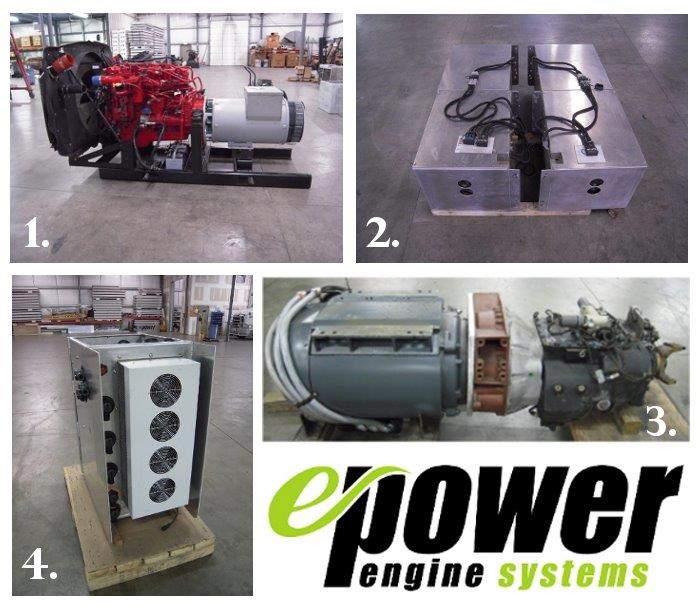
The conversion process is straightforward and ePower's kits can be installed by trained mechanics in any well-equipped garage.

Truckers are a skeptical lot and they don't put much credence in efficiency claims. In fact, they usually believe the only results that matter are the results they get with their cargos on their routes with their drivers. To overcome this skepticism, ePower will build a fleet of 10 converted tractors that it will loan or rent to fleet owners who want to test the drivetrain's performance in their business for periods ranging from a few weeks to several months. This demonstration strategy will:
- Increase ePower's visibility among potential customers;
- Validate ePower's performance claims with credible third-party data; and
- Help ePower accumulate over a million miles of reliability data per year.
The first time a customer orders an ePower conversion kit, they will send a tractor and a crew of mechanics to ePower's facility for a hands-on training course where the customer's mechanics will learn the ropes by doing the conversion work with our expert teaching staff. When the work is done, the customer will end up with a converted tractor and a mechanical crew that knows how to:
- Maintain the converted tractor, and
- Do additional conversions in the customer's shop.
ePower believes the ability to leverage existing infrastructure by selling drivetrain kits to fleet owners, truck dealers and large garages will speed adoption and help reduce the challenges associated with rapid growth.

ePower has made tremendous strides since demonstrating a "proof of principle" prototype in 2009. Through four generations of prototypes ePower has steadily increased the cruising speed, hauling capacity and gradeability of its drivetrain. It's fourth generation drivetrain with a 65 mph cruising speed and 74,000 pounds of hauling capacity (over 90% of cargos) began demonstration trials in April.
 ePower's foundation US patent (No. 8,793,396) was issued in July 2014 and expires in 2031. ePower also received its first international patent from Mexico in 2014. ePower is actively pursuing global patent protection under the International Patent Cooperation Treaty and plans to file several additional patent applications this year.
ePower's foundation US patent (No. 8,793,396) was issued in July 2014 and expires in 2031. ePower also received its first international patent from Mexico in 2014. ePower is actively pursuing global patent protection under the International Patent Cooperation Treaty and plans to file several additional patent applications this year.
 ePower owns two Class 8 tractors that use its series hybrid drivetrain. One is a 2005 model Peterbilt sleeper cab and another is a 2000 model Sterling day cab. ePower is presently converting a third tractor, a 2002 model Sterling day cab. ePower's third and fourth generation drivetrains have been tested in the rolling hills of northern Kentucky where they demonstrated the capacity to haul loads of up to 74,000 pounds at highway speeds with fuel efficiencies that represent a 40% to 60% improvement compared to conventional mechanical drivetrains.
ePower owns two Class 8 tractors that use its series hybrid drivetrain. One is a 2005 model Peterbilt sleeper cab and another is a 2000 model Sterling day cab. ePower is presently converting a third tractor, a 2002 model Sterling day cab. ePower's third and fourth generation drivetrains have been tested in the rolling hills of northern Kentucky where they demonstrated the capacity to haul loads of up to 74,000 pounds at highway speeds with fuel efficiencies that represent a 40% to 60% improvement compared to conventional mechanical drivetrains.
 ePower enjoys solid support from supply chain partners, fleet operators and a variety of environmental organizations.
ePower enjoys solid support from supply chain partners, fleet operators and a variety of environmental organizations.
ePower's supply chain partners including Cummins, and the Unico and Marathon Electric divisions of Regal-Beloit, contributed extensive engineering support that accelerated development of ePower's drivetrain. ePower's ability to rely on first-tier partners will help ensure a smooth launch with no supply chain bottlenecks.
The EPA recently confirmed that ePower can piggy-back Cummins' EPA emissions certifications. That confirmation shaved two or three years from the development timeline and several million dollars from the development budget.
Several Clean Cities Coalitions have helped ePower identify over $1 million of Federal grant funding under the Diesel Emissions Reduction Act that truck owners can use to help offset the cost of switching to an ePower drivetrain.


ePower showcased its drivetrain at the 2014 Battery Show and Electric & Hybrid Vehicle Technology Expo in Novi, Michigan.

ePower has been featured in Batteries International Magazine, as well as in The Trucker.


It all began in the late-90s when ePower's founder Jay Bowman was developing manufacturing systems for steel reinforced foam building panels. He was intrigued by AC vector drives – industrial control devices that manage the electric current in high speed assembly lines. He believed that vector drives could be ideal control systems for hybrid electric drivetrains. Unfortunately, vector drives were too costly at the time so Jay shelved the idea.
Jay revisited his hybrid drivetrain idea in 2009 and learned that vector drive costs had fallen to a point that made sense in heavy-duty trucking. So he bought an old Mack truck and built a proof-of-principle prototype.
Fast forward to today, ePower's fourth generation drivetrain began field trials in April with a group of independent contractors who haul freight for FedEx Ground and service 30 FedEx facilities in a multi-state region. The three primary goals of the initial field trials are to:
- Confirm ePower's fuel efficiency advantage;
- Validate the hauling capacity and drivability of ePower's tractor; and
- Evaluate the on-road performance of three advanced battery technologies.
ePower's first demonstration trial on April 29, 2015 was a 463 mile road test with three legs at increasing weights. The first leg from Florence, KY to Indianapolis, IN was run at a 66,000 pound GVW. A second leg from Indianapolis to Remington, IN was run at a 69,000 pound GVW. The third leg from Remington, IN to Florence KY was run with a 74,000 pound GVW.
Our fuel efficiency for the trial was 38% higher than the contractor's average. We did, however, experience unusually high battery temperatures on the third leg. In light of our recent drive motor upgrade and the 66,000 to 74,000 pound GVWs we hauled during the first trial, the elevated temperatures were not surprising. We are working with our battery supplier to pinpoint the causes and find ways to mitigate the heat issues. We also plan to test two alternative battery pack options before we proceed to the next stage of completing a 10-unit demonstrator fleet.


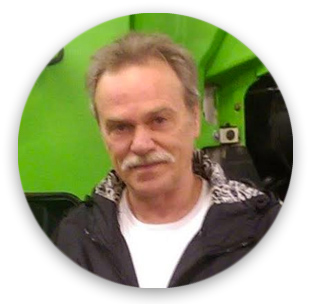 Jay invented ePower's series hybrid drivetrain and has been self-employed for the past 30 years. His first company provided packaging, logistics and billing services for defense contractors throughout the US. He subsequently took over his family's business of manufacturing reinforced polystyrene foam construction products and invented several new manufacturing systems. In partnership with Nova Chemical, Jay was instrumental in the construction of five factories on three continents. Since 2009, ePower has been Jay's passion.
Jay invented ePower's series hybrid drivetrain and has been self-employed for the past 30 years. His first company provided packaging, logistics and billing services for defense contractors throughout the US. He subsequently took over his family's business of manufacturing reinforced polystyrene foam construction products and invented several new manufacturing systems. In partnership with Nova Chemical, Jay was instrumental in the construction of five factories on three continents. Since 2009, ePower has been Jay's passion.


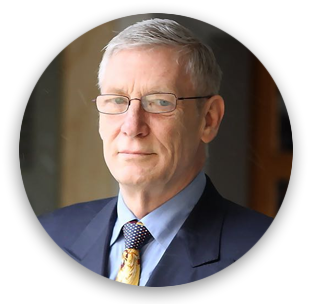 John is a lawyer and accountant with over three decades of corporate finance experience as counsel for a variety of entrepreneurial companies. John joined the ePower team in 2013. From 2003 to 2006, John served as a director of Axion Power International, including a two-year stint as Board Chairman. John graduated from Arizona State University and the Notre Dame Law School. He was admitted to the State Bar in Texas in May 1980 and licensed to practice as CPA in March 1981.
John is a lawyer and accountant with over three decades of corporate finance experience as counsel for a variety of entrepreneurial companies. John joined the ePower team in 2013. From 2003 to 2006, John served as a director of Axion Power International, including a two-year stint as Board Chairman. John graduated from Arizona State University and the Notre Dame Law School. He was admitted to the State Bar in Texas in May 1980 and licensed to practice as CPA in March 1981.


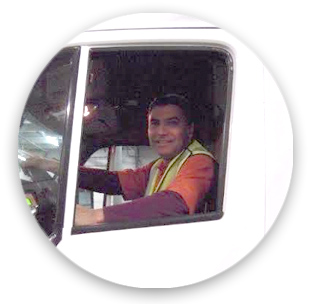
Mario has been the chief mechanic and Jay’s right hand for the past five years since the inception of ePower Engine Systems. He has built the Gen2, Gen3, and Gen4 prototypes from the wheels up and also conducts our on-road testing.


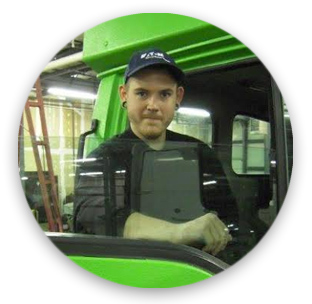
Andrew is responsible for developing and building the unique electrical systems that seamlessly integrates our hybrid drivetrain into existing Class 8 trucks.


Bob is a member of the board and is also helping develop proprietary electronic controls that will simplify the integration of a variety of engines, generators, drive motors, and transmissions into our drivetrain.
-
A Global Challenge
-
Our Target Market
-
Our Disruptive Fuel Effic...
-
Series Hybrid Drive for t...
-
Solid Patent Protection
-
Unique Power Solution
-
Unique Energy Recuperatio...
-
Unique Driver Efficiency...
-
Unique Modular Installati...
-
Unique Rollout Strategy
-
ePower Engine Systems So...
-
How It All Began
-
We Are ePower Engine Syst...
The Business Plan area is locked. You must Request Access to this company to see more information including the Business Plan.
Request Access
N
No updates yet.
%
No backers yet.
Quick Signup TBD
You must have an account to do this!
